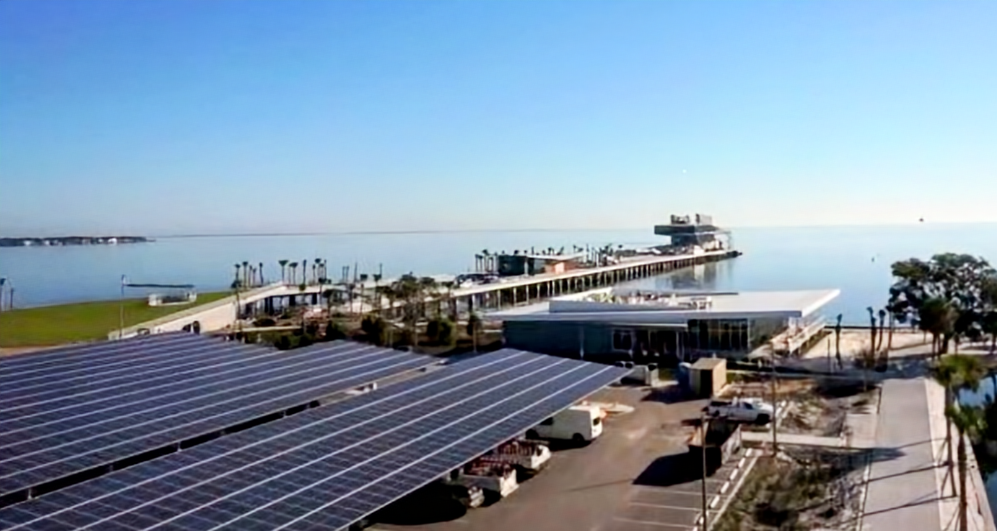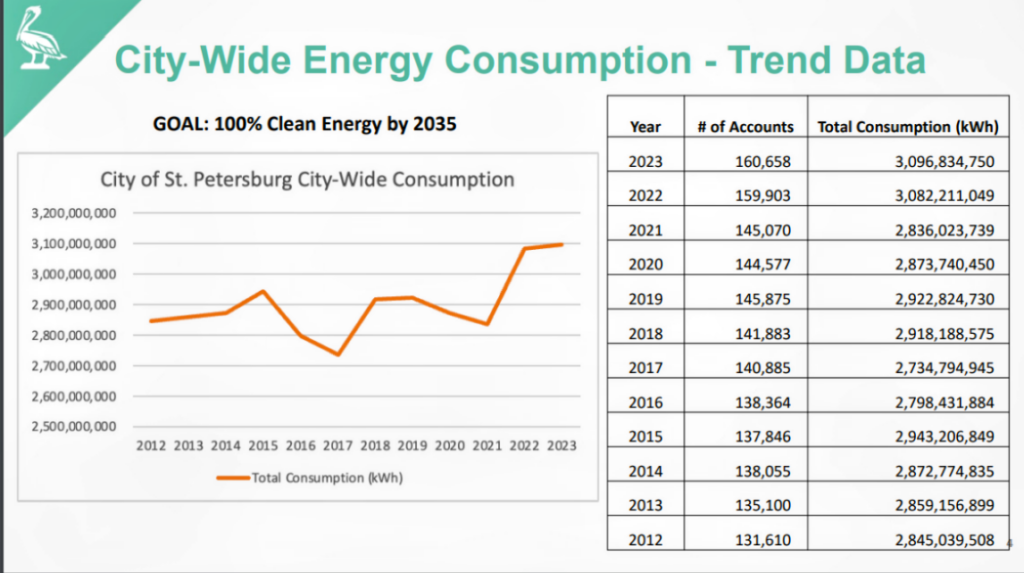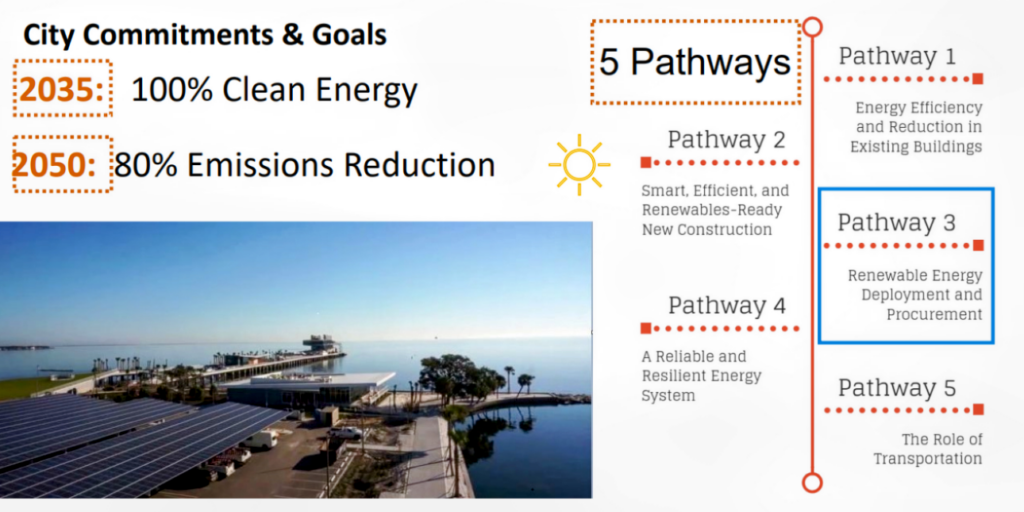Thrive
Is Duke helping St. Pete meet its sustainability goals?

In 2019, St. Petersburg became Florida’s first city to make an official “100% clean energy commitment,” with a 2035 target date. Quantifiable progress remains elusive.
City council members received power consumption data at a May 16 committee meeting for the first time since making that pledge and joining Duke Energy’s nascent Clean Energy Connection program in 2021. The subscription-based initiative allows customers to support its statewide solar plants and receive monthly bill credits.
St. Petersburg has received about 40% of the clean energy kilowatt hours it requested from Duke. The city’s power consumption has increased 9% since 2012.
“We have set an ambitious goal for ourselves and are falling far short is what it boils down to,” said Councilmember Richie Floyd. “It just doesn’t seem like much progress is being made.”
Councilmember Brandi Gabbard requested the presentation at a Health, Energy, Resilience and Sustainability Committee meeting in February. At the time, she said the city could explore forming a municipal electric utility as its 30-year contract with St. Petersburg-based Duke Florida expires in 2026.
The committee did not revisit that topic May 16. They did, however, receive some long-awaited data.
Alison Mihalich, sustainability and resilience director, explained that while energy consumption has increased by 9%, the number of electric customers has spiked 22% since 2012. She attributed that to “substantial population growth.”

A graphic highlighting the city’s energy consumption since 2012.
Residential usage outpaces the commercial and government sectors. Mihalic said the transition to working from home during the pandemic exacerbated that trend.
Over 14% of the state’s energy comes from the sun. Mihalic said that is a “decent amount” and expects a significant increase over the next decade.
City officials established five pathways to utilizing 100% clean energy by 2035 and an 80% emissions reduction by 2050. Mihalic said the Clean Energy Connection (CEC) program is a “powerful tool” that can help achieve those goals. Floyd called it “convoluted.”
“I don’t understand how the shares are done; I don’t know what the outcome is going to be,” he added. “I’m not personally comfortable investing in that … so it makes me skeptical on the city side, as well.”

A graphic highlighting the city’s five pathways to reaching its clean energy goals.
Derick Farfan, lead strategy and planning manager with Duke, attempted to explain the program twice. CEC customers pay an $8.35 monthly subscription fee and request an allotment of kilowatt hours they expect to use.
In addition to the typical mix of fossil fuel-derived energy sources, like natural gas, participants receive an additional allotment of solar power. Farfan said Duke now operates 10 statewide solar plants.
CEC participants receive solar power according to how much they invest in the fully subscribed program. While costs fluctuate, Farfan said the average customer spends about $1 more per kilowatt.
“The first years of the program – it is not going to lower the bill,” he said. “You’re going to be paying a little more on your bill every year until roughly around year eight or nine.”
Farfan said Duke could increase the city’s CEC allotment to about 59% of its requested amount. He added that the company needs a decision as soon as possible.
Gabbard stressed that the council and mayoral administration should make that determination collaboratively. “I want us to have comprehensive conversations about our renewable energy goals,” she said. “I just don’t want this to be something that happens in the back rooms and doesn’t get discussed out here in the light.”
Mihalic suggested installing city-owned solar facilities while the program matures. She also wants to see annual reports from Duke before increasing St. Petersburg’s CEC investment.
City officials also lack residential solar and citywide emissions data. “I would respectfully request that we keep this as a referral item,” Mihalic said. “Once we’ve completed that inventory, we can report back. And also report back on the renewable energy credits …”
Floyd said the committee would continue discussing the “complicated topic” at future meetings. The update followed a decidedly more straightforward and celebratory presentation.

Tampa Bay has lost 12% of its seagrass, which is critical to marine life and water quality. Photo courtesy of the Tampa Bay Estuary Program.
Mihalic began the meeting by highlighting how the city will spend its final $1.06 million in BP oil spill (formerly British Petroleum) settlement funding. Administrators removed an $850,000 tree inventory study from the initial proposal and will now provide Tampa Bay Watch with $403,000 to support seagrass restoration efforts.
The revised proposal also includes $400,000 for energy-efficient municipal building upgrades and electric vehicle infrastructure, $150,000 to create two new community food forests, $75,000 for nonprofit operators and $35,000 for a tree canopy analysis.
The committee unanimously praised the proposal, which the full city council must now approve. “To say I’m excited would be a dramatic understatement,” Gabbard said. “Those things directly correlate to why we have that money.
“Thank you for understanding what the community has been asking for – for a very long time.”








Kate
May 22, 2024at4:04 pm
I work in the energy industry. Outside of this particular program, this CEC idea is called Community Solar. Electric bills are high enough – people don’t want to pay for an additional subscription, especially if they won’t save money for 8 years. Money talks. We would be better served if Duke had more robust commercial and residential energy efficiency and demand response programs. Pass a city building energy benchmarking ordinance so buildings see how much they are using every year to spark action.
Steven Brady
May 21, 2024at3:14 pm
Kilowatt hours and kilowatts are completely different types of measurements. I am shocked that there is no comparison about actual rates paid by people in the St. Petersburg area. And what they would be going green. Especially with the horrendous inflation we’ve been seeing .
There are costs associated with any public policy.
Here we have no idea what the costs are for consumers. A lot of words with little useful information here. No one reading this article will have any idea whether they will be paying more per kilowatt hour or or less or anything in between.
Grid solar is usually contracted out for a fixed price per kilowatt hour. That would’ve been interesting to know as well.
In case somebody is curious… from artificial intelligence
### Understanding Kilowatts (kW) vs. Kilowatt-Hours (kWh)
**Kilowatts (kW) and Kilowatt-Hours (kWh)** are two different units used in the context of electricity, and it’s important to understand the distinction between them.
#### Definitions:
– **Kilowatt (kW):** A unit of power. It measures the rate at which electricity is used at a specific moment. 1 kW = 1,000 watts.
– **Kilowatt-Hour (kWh):** A unit of energy. It measures the total amount of electricity consumed over time. 1 kWh = 1 kilowatt of power used for one hour.
#### Key Difference:
– **Kilowatt (kW)** is like the speedometer in a car; it tells you the rate of energy usage at a specific moment.
– **Kilowatt-Hour (kWh)** is like the odometer in a car; it tells you the total energy consumed over a period.
### Basic Math Example:
**Scenario:** Let’s say you have a 1 kW electric heater and you use it.
#### Power (kW):
– The heater has a power rating of 1 kW. This means it uses 1,000 watts of power at any given moment when it’s on.
#### Energy (kWh):
– If you run this 1 kW heater for 1 hour, it will consume 1 kWh of energy.
– **Calculation:** \( 1 \, \text{kW} \times 1 \, \text{hour} = 1 \, \text{kWh} \)
#### Comparison Over Time:
– **Using the heater for 3 hours:**
– Power: Still 1 kW (constant rate of energy usage).
– Energy: \( 1 \, \text{kW} \times 3 \, \text{hours} = 3 \, \text{kWh} \)
– **Using the heater for 5 hours:**
– Power: Still 1 kW.
– Energy: \( 1 \, \text{kW} \times 5 \, \text{hours} = 5 \, \text{kWh} \)
### Misleading Comparisons:
– Comparing kilowatts (power) to kilowatt-hours (energy) is like comparing speed to distance. They relate to each other but represent different concepts.
– **Speed (kW) tells you how fast you’re going at any moment.**
– **Distance (kWh) tells you how far you’ve traveled over a period.**
#### Analogy:
– If a car is traveling at 60 miles per hour (mph), saying “I’ve driven 60 mph” doesn’t convey how far you’ve gone.
– Similarly, if an appliance uses 1 kW of power, saying “I’ve used 1 kW” doesn’t tell you the total energy consumed unless you specify the time period (e.g., “I’ve used 1 kWh”).
### Conclusion:
Understanding the difference between kW and kWh is crucial for interpreting electric bills and managing energy consumption effectively. Always remember that power (kW) is the rate of usage, and energy (kWh) is the total usage over time.